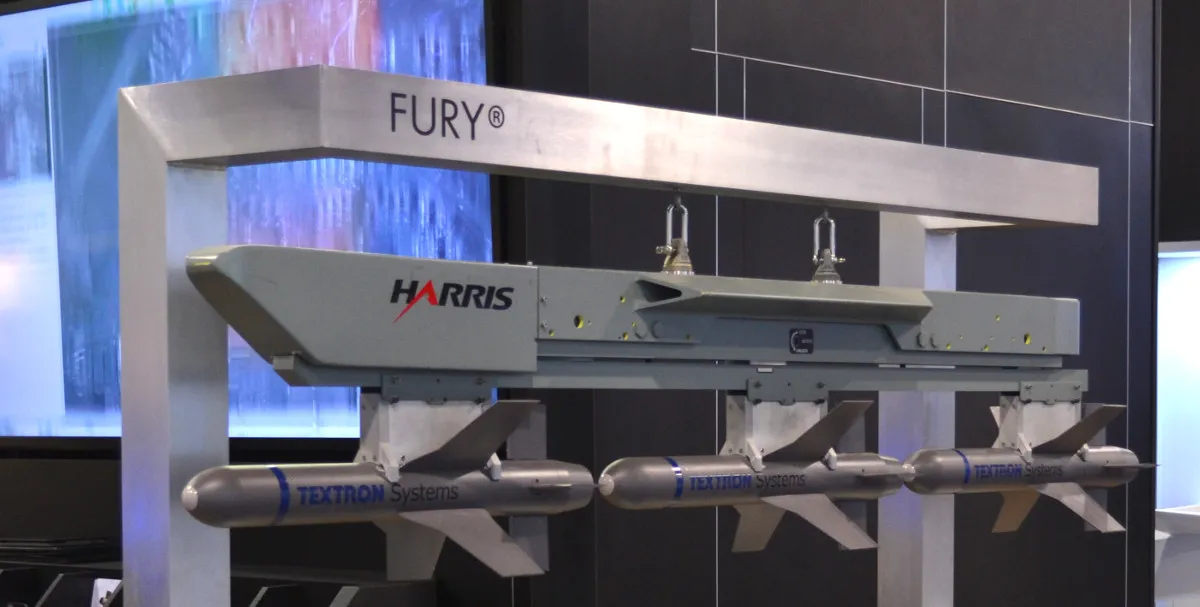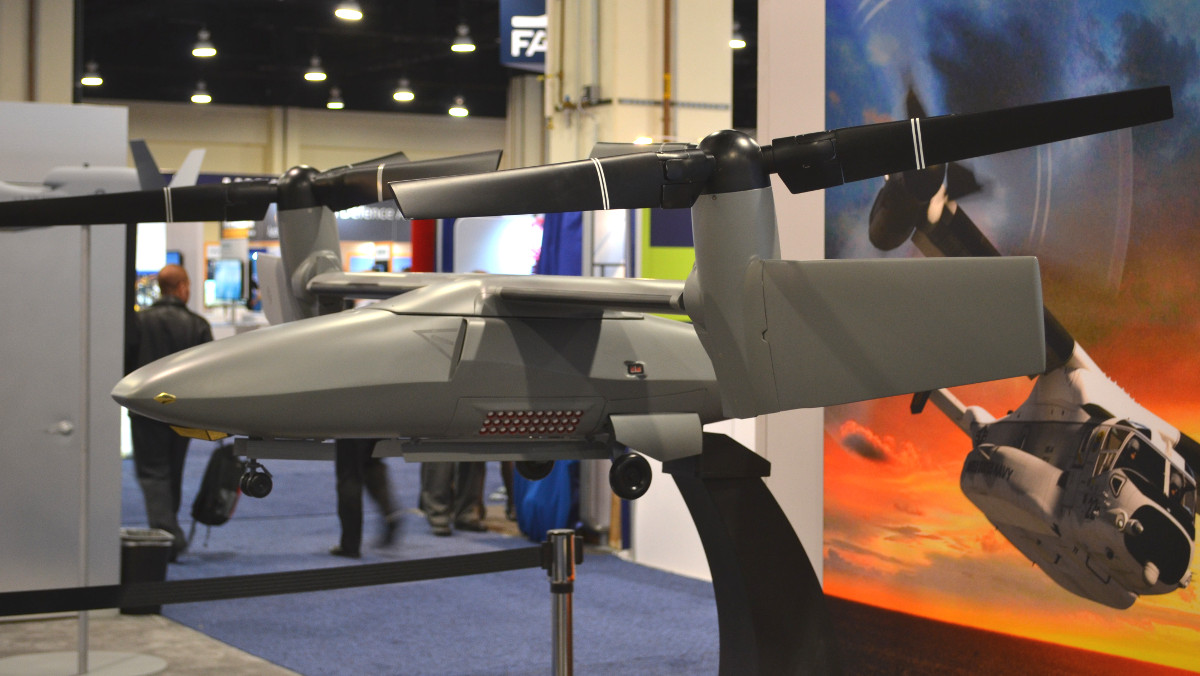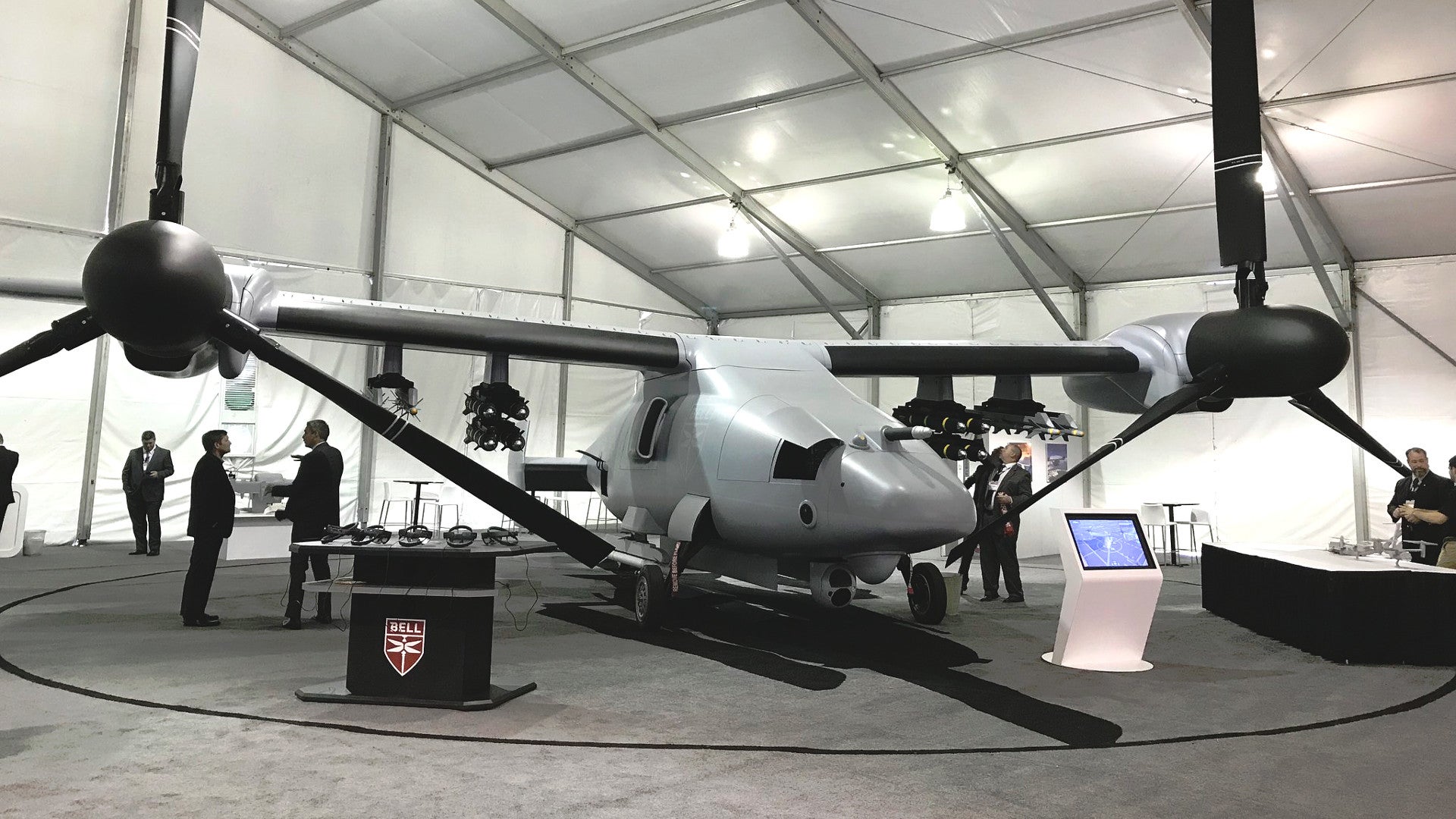As the U.S. Marine Corps looks to move ahead with its multi-role, vertical landing and takeoff-capable drone program, known as MUX, Bell has unveiled a new, full-scale mock-up of its V-247 Vigilant unmanned tilt-rotor at a technology exposition at one of the service’s own bases. The company has been actively pitching the design as an option for MUX project, but it has a modular design that could make it appealing to other U.S. and foreign military services, as well.
Bell showed the full-size model to the public for the first time at the 2018 Modern Day Marine Expo at Marine Corps Base Quantico in Virginia on Sept. 25, 2018. The firm first announced it was working on the V-247 design at all in 2016, around the same time that the Marines first revealed the MUX concept, which officially stands for Marine Air Ground Task Force Unmanned Aircraft System Expeditionary.
“The Bell V-247 Vigilant is leveraging combat-proven technology making the future of aviation a reality today,” Todd Worden, Bell’s Senior Manager for Global Military Business Development speaks, told attendees at the Modern Day Marine Expo while standing in front of the model. “It’s a testament to the power and versatility of tilt-rotor flight.”
The V-247 uses technology derived from both the V-22 Osprey tilt-rotor, which the Marines already fly, as well as the still-in-development V-280 Valor, which the company has pitched to the U.S. Army as part of the Future Vertical Lift (FVL) program. The unmanned Vigilant will be capable of autonomous flight and will have the necessary data links to support teaming up with manned aircraft, according to Bell. The company also says the drone can turn its wings and fold its rotors in order to fit within the same physical footprint as a Marine UH-1Y Venom utility and light attack helicopter, which is a key MUX requirement.
The company has long pitched the design as a multi-purpose platform, with multiple internal payload bays for weapons, radars and other sensors, and other specialized mission equipment. The new model is in a light attack configuration with four underwing pylons and sensor turret under the fuselage that could carry various electro-optical and infrared cameras, as well as a laser designator.
Bell’s mock-up at the Modern Day Marine Expo was carrying four dummy AGM-114 Hellfire missiles and a dozen inert Fury multi-mode precision-guided miniature munitions. Textron, Bell’s parent company, produces Fury, which is a small glide bomb that can use either laser or GPS/INS guidance options to attack stationary or moving targets in various weather and environmental conditions.

What the Marines refer to as “Offensive Air Support” is relatively low on their priority list for the MUX drone, ranked fifth out of seven total potential missions for the system, according to documents the service publicly released in June 2018. An airborne early warning platform is the Corps’ most pressing demand as it is a capability the Marines presently rely on other services to provide. You can read about the MUX’s possible mission profiles in greater detail in a past War Zone feature on this system.
The modular nature of the V-247 could give it the capacity necessary to carry the powerful air search radar necessary for the airborne early warning mission. The Vigilant in this configuration would also need significant communications systems and data links necessary to send out critical information to other Marine assets and command centers.
The V-247 model at the Modern Day Marine Expo also notably features an in-flight refueling probe, which was not present on earlier models and in previous concept art of the design. This feature, combined with the Marines’ plans to adopt an aerial refueling tanker kit for the Osprey, would help extend the overall range of the drones or allow them to loiter over a particular area of the battlefield for extended periods of time. This could be especially useful for examples of the drone operating in the airborne early warning role, but would also be valuable for versions flying other MUX missions, such as persistent surveillance, armed over-watch, and communications relay missions.

Unfortunately, Congress has not been as enthused about the Marine Corps’ plans for MUX, regardless of what design they might use in the end, raising concerns that the service has not properly outlined its need for the system or now they plan to integrate it into their overall force structure. Legislators cut nearly the service’s proposed budget for the program by nearly half, from around $25 million to approximately $14 million, when they passed the defense policy bill for the 2019 fiscal year in August 2018.
The Marines are moving forward with the project, regardless, but they’re also unlikely to be the only element of the U.S. military that might be interested in using the Vigilant to fill many of the same missions. One of the driving factors in the V-247’s design was also the desire to make it able to fit inside the hangar on board an Arleigh Burke-class destroyer, which could make it appealing to the U.S. Navy. Bell has previously shown a model of a version in an anti-submarine warfare configuration with a side-mounted sonobouy launcher. The Navy is also working separately with the Defense Advanced Research Projects Agency and Northrop Grumman on another vertical take-off and landing capable maritime strike and reconnaissance drone project called the Tactically Exploited Reconnaissance Node (TERN).

The Army is also exploring the possibility of fielding some form of multi-role, pilot optional, vertical take-off and landing capable aircraft, which could be either a helicopter or a tilt-rotor. The V-247 can’t carry a pilot and is probably too small to meet this and other requirements for this Future Attack Reconnaissance Aircraft Competitive Prototype (FARA CP), but the design could serve as the basis of future Bell offering for the program.
The Vigilant also could be of interest to foreign military operators, as well. With Bell’s emphasis on the drone’s shipboard capabilities, the company might be inclined to pitch it to Japan or South Korea, both of which are looking to significantly expanding the amphibious warfare capabilities. Both countries could soon be interested in operating the vertical take-off and landing capable F-35B Joint Strike Fighter from new and existing amphibious assault ships and light carriers. The Marines see their future MUX operating together with these stealthy fighters on some missions, as well.

Japan is also the first, and still only, V-22 export customer and could eventually fly them from the country’s Izumo-class “helicopter destroyers,” which Japanese authorities have now conceded were originally designed as light aircraft carriers. One of the missions the Marines first envisioned for MUX was escorting Ospreys as they flew ashore.
Whatever happens to MUX in the end, as well as another U.S. military or foreign drone program that considers the V-247 design, Vigilant appears to have a lot of potential and it’s likely that we’ll see more notional configurations for various missions as Bell gets the aircraft ready for its inaugural flight. This could come in the next few years if the company hopes to stick to its plan of having the unmanned tilt-rotor ready for production by 2023.
Contact the author: jtrevithickpr@gmail.com
